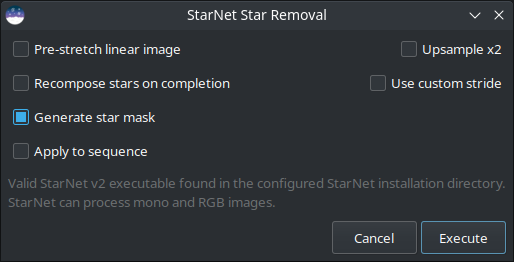StarNet Star Removal
StarNet is a software developed by Nikita Misiura. Its first version was released under a free and opensource license. Unfortunately, version 2 became proprietary and the sources are since closed. The version 2 is available free of charge from there. Make sure you download the Command Line Tool version. Siril can interface with any version of the StarNet CLI tool, including the new experimental Torch-based version that has initially been released for M1- and M2- based Apple Macs.
Warning
If you are wondering why StarNet doesn’t launch, please run it outside Siril first. It’s not Siril’s fault if it’s not supported by your computer or badly installed for some reason. If your processor does not support the vectorization instructions required by StarNet, there is no way to bypass that. The error message will be obtained by executing StarNet alone.
Tip
On MacOS, for Siril to detect and use StarNet correctly, it is necessary
to fix some permissions and security issues first. Start by opening the
Terminal application from the Utilities folder within Applications. In
Terminal, you need to change your working directory from your home directory
to the StarNetCLI installation directory. To do this type in cd followed
by a space and then drag the StarNetCLI folder into the terminal
window to copy its path. Press enter. Then type in the following four
commands, pressing enter after each one:
xattr -r -d com.apple.quarantine libtensorflow_framework.2.dylib
xattr -r -d com.apple.quarantine starnet++
chmod +x starnet++
chmod +x run_starnet.sh
Then, at the first use with Siril, the execution of StarNet may fail with a warning about libtensorflow. Cancel out of this warning. Open System Preferences and under Privacy and Security click the Allow anyways button for libtensorflow. After this, StarNet should execute properly in Siril.
Tip
On MacOS, again, there is a new Starnet executable optimized for the Apple Silicon chip that has been released on the site: https://www.starnetastro.com/experimental/. This new version is much faster than previous version because it uses the new MPS accelerated PyTorch (https://developer.apple.com/metal/pytorch/). Also, this version contains signed binaries, follow the installation instructions in the README.txt
However, it is still possible for Siril to run external binaries and this is what we decided to implement starting with Siril 1.2.0. For the settings, please refer to the preference page. It explains how to tell Siril where StarNet is located.
Warning
This is the location of the command line version of StarNet that need to be given, not the GUI one.
Note that StarNet requires its input in the form of TIFF images, therefore if Siril is compiled without libtiff support then the StarNet integration will not be available.
The primary purpose of StarNet is to remove all the stars from the images in order to apply a different process between the stars and the rest of the image. This usually helps to control star bloat during the different stretches, but it is also very useful for creating images of comets where the comet tracking rate can be significantly different to the distant stars.

StarNet dialog box.
The tool is very easy to use and only five options are available:
Pre-stretch linear image: If selected, an optimised Midtone Transfer Function (MTF) stretch is applied to the image before running StarNet, and the inverse stretch is applied on completion. This is necessary for using StarNet at the linear stage of processing.
Recompose stars on completion: If selected, on completion of the star removal process the star recomposition tool will open, providing an interface for independently stretching and blending the background and the stars if star reduction, rather than total removal, is desired. This option has no effect when processing a sequence.
Generate star mask: This will generate a star mask and saved it in the working directory. The star mask is calculated as the difference between the original image and the starless image. The default is to produce a star mask.
Upsample x2: This option will up-sample the image by a factor of 2 before running StarNet. This improves performance on very tight stars but quadruples processing time and may impair performance on very large stars. The image is rescaled to the original size on completion.
Use custom stride: A custom value may be entered for the StarNet stride parameter. The default value is 256 and the StarNet developer recommends not to change this.
The StarNet process can easily be applied to a sequence. The togglebutton Apply to sequence selects whether the process will apply to a single image or to a sequence. Where the process is applied to a sequence, a new sequence will be created containing the starless images and, if star mask generation is selected, a second sequence will be created containing the corresponding star mask images.
More information about StarNet can be found on the original website.
A click on Execute will run the process. It can be slow, depending of your machine performance. However, Siril shows a progressbar to follow the processing. As with other Siril processes, if processing a sequence the progressbar will only update after completion of each image in the sequence, and will show the overall progress through the sequence.
Commands
Siril command line
starnet [-stretch] [-upscale] [-stride=value] [-nostarmask]